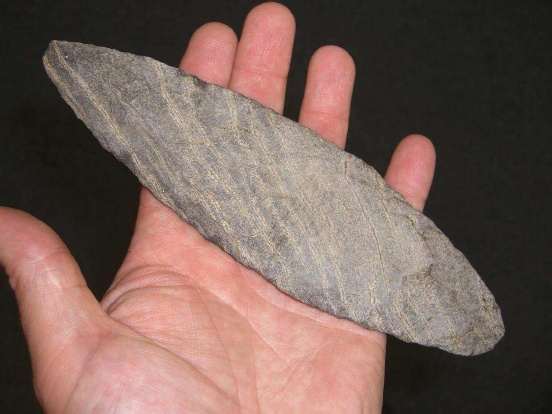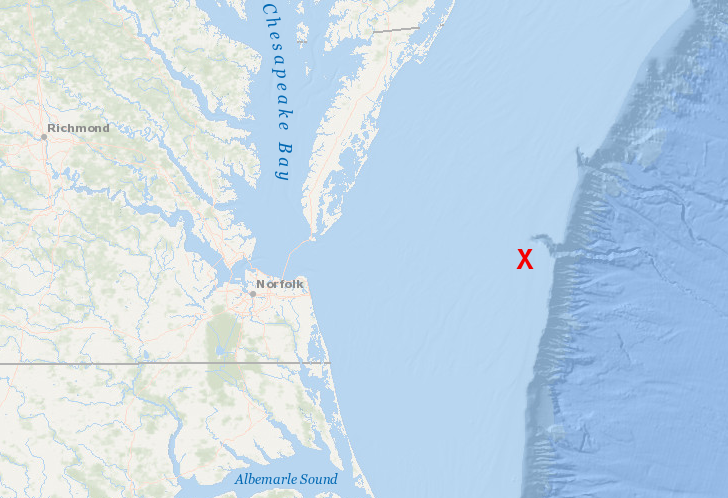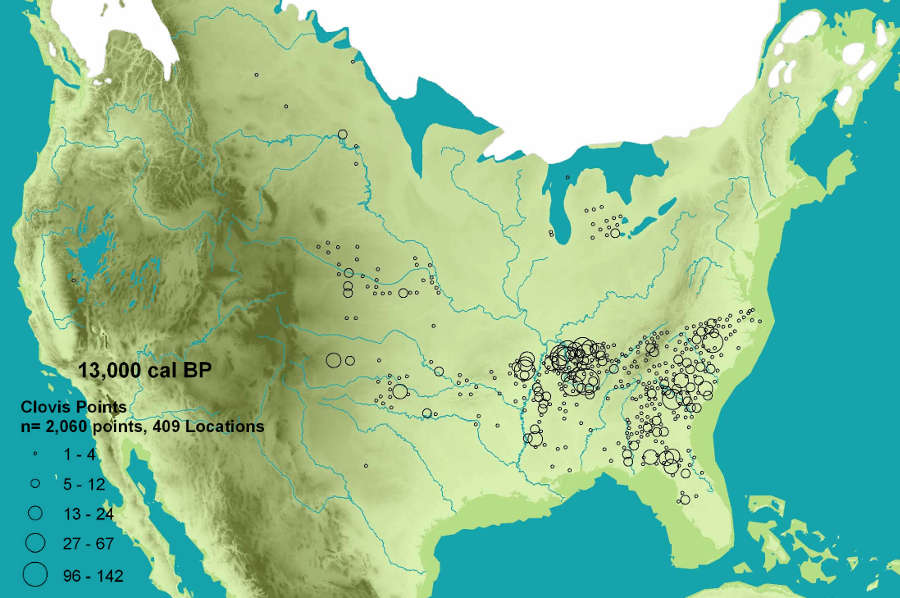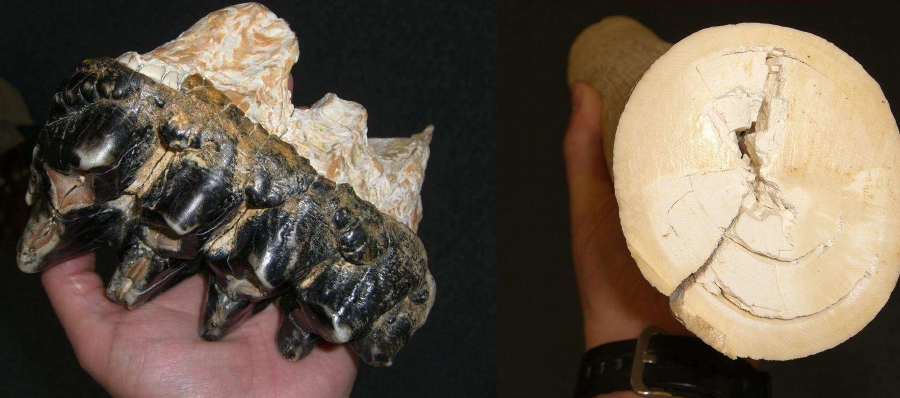Solutrean Hypothesis - Were the First Virginians From Europe, Rather than Asia?

the scallop dredger Cinmar brought a rhyolite point to the surface in 1970, together with a mastodon skull dated at over 20,000 years old
Source: Academia, A Response to the paper entitled "The CINMAR discovery and the proposed pre-Late Glacial Maximum occupation of North America" by Three University of Missouri Scholars
Roughly 6,000-10,000 hunters and gatherers survived on the Bering land bridge during the Last Glacial Maximum about 20-25,000 years ago. The initial residents of that area had arrived 40,000 years ago, then been isolated for at least 2,400-9,000 years by ice sheets as the climate cooled. When the climate warmed and glacial ice retreated from the shoreline, some moved into North America.
By that time, the small group of hunters and gatherers living on Beringea had developed genetic patterns that were no longer "Asian." Genetic analysis of mitochondrial DNA reveals:1
- The molecular genetic support for a Beringian occupation is elegant - the same four founding mtDNA haplogroups are distributed throughout North and South America, but are not found in Asia (the fifth founding haplotype, mtDNA X2a, is absent in South America...
The immigrants from Siberia and then Beringea are traditionally considered to be the ancestors of all the people living in the Western Hemisphere before the arrival of Europeans. However, there may have been another migration, in addition to settlement by people moving out of Beringea.
Two scholars, Dennis Stanford from the Smithsonian Institution and Bruce Bradley from the University of Exeter in England, proposed a theory of immigration from Europe via the Atlantic Ocean over 20,000 years ago.2
The Solutrean Hypothesis is based on similarities between the Clovis style of Paleo-Indian points and points manufactured in the Loire River area in France, near the village of Solutre-Pouilly. Both use the overshot flaking technique for processing a chunk of stone into a tool.
Knappers, people who created stone tools, used percussion and pressure to remove flakes of rock to create sharp edges. Special skill was required remove a large flake that crossed from one face to the opposite edge of the point. The imbedded biface technology resulted in wide, thin tools. Clovis points, in addition, had a distinctive flute at the bottom of the point. That flute made it easier to "haft" (attach) the point to a spear.3
The most significant piece of evidence for the Solutrean Hypothesis is a stone blade, a bifacial knife manufactured by the overshot flaking technique. The artifact was recovered by the scallop trawler Cinmar in 1974 (some reports indicate 1970). The blade was found in the same dredge haul as a mastodon skull, from water 240 feet deep nearly 60 miles off Cape Charles.

the Cinmar found a mastodon skull and a biface blade while dredging for scallops over 50 miles from the current shoreline
Source: ESRI, ArcGIS Online (based on Figure 4.8 in Across Atlantic Ice: The Origin of America's Clovis Culture)
The crew cut up the mastodon skull for souvenirs. The point, plus a segment of a mastodon tusk and a tooth, ended up on display at the Gwynn's Island Museum. An archeologist surveying sites on eroding coastlines in Mathews County visited the museum to assist in classifying its archaeological collections.
He realized the significance of the biface tool, and recognized it as rhyolite with a "chalky" patina. That indicated the item had been manufactured from stone brought from the Blue Ridge far to the west, and weathered on the surface for 500 years after being lost/discarded. Sea level rise had drowned the discovery site soon after the end of the Last Glacial Maximum, so the artifact dated from early human occupation of North America.4
The tusk was dated to about 23,000 BP (Before Present). The stone blade itself can not be dated using radioactive techniques, but if you assume the skull and the stone tool were deposited at the same time, then they date from the time of the Solutrean culture in France and Spain. That was 23,500-18,000 BP. By the time people in Virginia were making Clovis points around 13,500 BP, the site dredged by the Cinmar was almost 50 feet underneath the rising waters of the Atlantic Ocean.
Dennis Stanford and Bruce Bradley have proposed that people making Solutrean points used boats to move along the edge of the ice sheet during the Last Glacial Maximum, hunting marine mammals and paddling westward until reaching the North American continent. The stone tool found by the Cinmar was a knife lost as some of the first people in Virginia killed and butchered a mastodon trapped in a bog. Both the knife and skull were buried in anaerobic bog sediments and preserved, until being dredged to the surface over 20,000 years later.
Perhaps the blade was rafted in a flood with tree trunks embedded in ice, floating out into the ocean. If the knife had been washed down from a site more recently, from a site further west, then the edges would have been rounded and the artifact would not have survived transport intact.
Another alternative is that
1) someone in a boat, many years later, lost the blade over the side
2) it coincidentally landed on the mastodon skull site, and
3) by chance a scallop trawler excavated the younger blade and the older skull at the same time.5
Many other archeologists have found shortcomings in the Solutrean Hypothesis.
If the Solutrean people had the capacity to travel by boat across the Atlantic Ocean, then there should be evidence that they also traveled to nearby islands in Europe. The distinctive points are not found on the different islands in the Mediterranean, though that may reflect insufficient archeology and the likelihood that sites from the Solutrean period are underneath 300 or more feet of water.6
Also missing from the archeological record is evidence that the Solutrean culture on the shoreline of Spain and France hunted marine mammals consistently, developing the skills needs to subsist on such food during a migration westward of over 3,500 miles. Due to sea level rise, such sites may exist, but be underneath 300-400 feet of water now and inaccessible to archeologists until new technology evolves.7
A serious challenge to the hypothesis is the disconnect between the date of the mastodon tusk and the time the Solutrean culture developed. The mammoth died 3,000 years before the Solutrean lithic industry developed from the predecessor Gravettian in Europe. Unless dates are revised by later research, for a Paleo-Indian hunter to kill that particular mammoth with a Solutrean-shaped point would require traveling backwards in a time machine.8
If the blade brought to the surface by the Cinmar really is as old as the mastodon skull, then it is 7,000 years older than the Clovis culture. No other North American culture has maintained the same style of processing stone over such a long period. As environmental conditions have changed, as plants to be cut and animals to be skinned have changed, cultures have not been static. Their approaches to chipping stone have changed, new technologies for manufacturing points and blades have been adopted, over periods measured in just centuries.
It is true that archeologists have found more sites with Clovis points east of the Mississippi River. The Solutrean Hypothesis assumes arrival from Europe at a pre-Clovis time period, and that later Clovis knappers retained the overshot flaking technique brought across the Atlantic Ocean. The distinctive flute could have been the one design change added by the Clovis knappers.
What may be relevant is that the oldest sites with pre-Clovis technology are on the East Coast. Cactus Hill, for example, was occupied 18,000-20,000 years ago, when the Solutrean points were still being produced in Europe.
If Paleolithic Europeans had migrated along the edge of the Atlantic Ocean ice sheet and brought their distinctive stone flaking to Virginia first, then the technology would have diffused from the East Coast towards the West Coast. The oldest pre-Clovis sites are on the eastern side of the Mississippi River. That evidence could be interpreted to support the validity of the Solutrean Hypothesis, but could also be interpreted to counter it. The development, adoption, and transition away from Clovis points occurred in less than 1,000 years. If early migrants brought the Solutrean design 7,000 years before the flute was added to create Clovis points, then a long-static society switched to rapid technological change.9

the oldest sites with Clovis points are west of the Mississippi River, but there are more sites east of the river
Source: Paleoindian Database of the Americas, Total number of reported Clovis Projectile Points
Evidence from DNA analysis has not supported European migration into North America prior to the arrival of the Vikings and later sailors. The genome of 9,000 year old Kennewick Man shows no link to European descent. Neither does the DNA from the 13,000-year old burial of a child found at the Anzick site in Montana, or 13,000 year old "Naia" found in a Yucatan cave.10
"Absence of evidence" is not conclusive proof of "evidence of absence," but extraordinary claims require extraordinary proof. Debate about pre-Clovis sites was robust, even bitter, for decades. Archeologists could visit excavations at Monte Verde, Meadowcroft Rockshelter, similar sites and judge for themselves if the stratification and dating met their standard of proof.
In contrast, the best evidence for the Solutrean Hypothesis is just one artifact dredged from the Outer Continental Shelf east of Virginia, recovered out of context from the surroundings. That singularity makes it difficult to reach an evidence-based conclusion.
The archeological claims were conflated by advocates for a European origin of Native Americans and a "white" heritage for America into a race-based argument. They circulated various forms of the Solutrean Hypothesis highlighting the claim that Europeans rather than Asians populated the Western Hemisphere, and that claim clouded the scientific discussion. Associating the theory with unpopular racist beliefs did not enhance the consideration of the hypothesis.
Technology for underwater archeology may someday allow for excavation of the site from which the Cinmar biface was found, or of other underwater sites that date back to the pre-Clovis time period. Florida has already excavated a 7,000-year old graveyard from the Archaic Period, carefully exploring a site that was 21' below the surface and identifying organic remains such as textile fragments.11
Until other evidence is found to link some European migration to North America 20,000 years ago, proof of the Solutrean Hypothesis will remain difficult. There is a 5,000-yar gap between the last artifacts of the Solutrean culture found in Europe and the date of the artifact dredged up by the Cinmar. If the two are connected, then there should be more evidence of the Solutrean culture surviving with a consistent style of lithic tool manufacture during that long gap.12
The current dominant perspective among anthropologists is that:13
- ...a so-called Beringian population would have diverged from Siberian populations around 36,000 years ago. About 25,000 years ago, the Beringians became isolated, and a new genetic population emerged, one that scientists have confirmed relates to contemporary Native American people, splitting into two main lineages around 17,000 years ago...
- ... one population may have spent thousands of years in Beringia, a period known as the Beringian standstill, before spreading into the Americas sometime during the Last Glacial Maximum between 27,000 and 19,000 years ago.

the mastodon skull, dredged up with the rhyolite point in 1970, was cut up by the Cinmar crew to share as souvenirs
Source: Academia.edu, A Response to the paper entitled "The CINMAR discovery and the proposed pre-Late Glacial Maximum occupation of North America" by Three University of Missouri Scholars
Links
- Canadian Broadcasting Corporation
- Hoyo Negro
- National Geographic
- NOVA
- Texas A&M University
References
1. "First Americans lived on land bridge for thousands of years, genetics study suggests," The Conversation, February 28, 2014, http://theconversation.com/first-americans-lived-on-land-bridge-for-thousands-of-years-genetics-study-suggests-23747; "Pause Is Seen in a Continent's Peopling," New York Times, March 12, 2014, https://www.nytimes.com/2014/03/13/science/linguistic-study-sheds-new-light-on-peopling-of-north-america.html; John F. Hoffecker, Scott A. Elias, Dennis H. O'Rourke, "Out of Beringia?," Science, Volume 343 Issue 6174 (February 28, 2014), http://science.sciencemag.org/content/343/6174/979.full; "Searching for the Origins of the First Americans," Sapiens, July 22, 2016, https://www.sapiens.org/archaeology/bering-land-bridge-first-americans/; Connie J. Mulligan, Emoke J.E. Szathmary, "The peopling of the Americas and the origin of the Beringian occupation model," American Journal of Physical Anthropology, Volume 162, Issue 3 (March 2017), http://10.1002/ajpa.23152 (last checked June 26, 2018)
2. Dennis J. Stanford, Bruce A. Bradley, Across Atlantic Ice: The Origin of America's Clovis Culture, University of California Press, 2012, https://books.google.com/books/about/Across_Atlantic_Ice.html?id=hq8cUUHPRJkC (last checked February 24, 2018)
3. Bruce Bradley, "Clovis intentional bifacial overshot flaking: Two replica examples," Journal of Lithic Studies, Volume 3, Number 1 (September 15, 2016), (last checked February 28, 2018)
4. Metin I. Eren, Matthew T. Boulanger, Michael J. O'Brien, "The Cinmar discovery and the proposed pre-Late Glacial Maximum occupation of North America," Journal of Archaeological Science: Reports, Volume 2, June 2015, Pages 708-713, https://doi.org/10.1016/j.jasrep.2015.03.001; Darrin Lowery, "A Response to the paper entitled 'The CINMAR discovery and the proposed pre-Late Glacial Maximum occupation of North America' by Three University of Missouri 'Scholars,'" Academia.edu, May, 2015, https://www.academia.edu/12645256/A_Response_to_the_paper_entitled_The_CINMAR_discovery_and_the_proposed_pre-Late_Glacial_Maximum_occupation_of_North_America_by_Three_University_of_Missouri_Scholars_; Andy White, "Shots Fired in the Battle Over the Cinmar Biface . . . But Does it Actually Matter to the Solutrean Hypothesis?," Andy White Anthropology blog, May 31, 2015, https://www.andywhiteanthropology.com/blog/shots-fired-in-the-battle-over-the-cinmar-biface-but-does-it-actually-matter-to-the-solutrean-hypothesis (last checked February 24, 2018)
5. Dennis J. Stanford, Bruce A. Bradley, Across Atlantic Ice: The Origin of America's Clovis Culture, University of California Press, 2012, pp.101-105, https://books.google.com/books/about/Across_Atlantic_Ice.html?id=hq8cUUHPRJkC (last checked February 24, 2018)
6. Gary Haynes, The Early Settlement of North America: The Clovis Era, Cambridge University Press, 2002, p.111, https://books.google.com/books?id=z8_7hI_88j4C (last checked February 24, 2018)
7. Andy White, "Shots Fired in the Battle Over the Cinmar Biface . . . But Does it Actually Matter to the Solutrean Hypothesis?," Andy White Anthropology blog, May 31, 2015, https://www.andywhiteanthropology.com/blog/shots-fired-in-the-battle-over-the-cinmar-biface-but-does-it-actually-matter-to-the-solutrean-hypothesis; Michael J. O'Brien, Matthew T. Boulanger, Mark Collard, Briggs Buchanan, Lia Tarle, Lawrence G. Straus, Metin I. Eren, "On thin ice: problems with Stanford and Bradley's proposed Solutrean colonisation of North America," Antiquity, Volume 88, Issue 340 (June 1, 2014), pp.606-613, https://doi.org/10.1017/S0003598X0010122X; Matthew T. Boulanger, "The origins of the first settlers in the Americas," Academia.edu, https://www.academia.edu/5119515/On_thin_ice_Problems_with_Stanford_and_Bradley_s_Solutrean-Clovis_hypothesis (last checked February 24, 2018)
8.
Gary Haynes, "The Millennium before Clovis," PaleoAmerica, Volume 1, Issue 2 (April 2015), p.137, https://doi.org/10.1179/2055556315Z.00000000016 (last checked August 8, 2019)
9. Jennifer Raff, "Rejecting the Solutrean hypothesis: the first peoples in the Americas were not from Europe," The Guardian, February 21, 2018, https://www.theguardian.com/science/2018/feb/21/rejecting-the-solutrean-hypothesis-the-first-peoples-in-the-americas-were-not-from-europe; Michael J. O'Brien, "More (and more) on Clovis," Antiquity, Volume 90, Issue 350 (April 2016), p,525 https://doi.org/10.15184/aqy.2016.27 (last checked February 24, 2018)
10. Jennifer A. Raff, Deborah A. Bolnick, "Does Mitochondrial Haplogroup X Indicate Ancient Trans-Atlantic Migration to the Americas? A Critical Re-Evaluation," PaleoAmerica, Volume 1, Issue 4 (2015), p.301, https://doi.org/10.1179/2055556315Z.00000000040; "New DNA Results Show Kennewick Man Was Native American," New York Times, June 18, 2015, https://www.nytimes.com/2015/06/19/science/new-dna-results-show-kennewick-man-was-native-american.html; "Anzick Clovis Site - Clovis Period Burial in Montana, USA," Thought.co, March 12, 2017, https://www.thoughtco.com/anzick-clovis-site-montana-usa-172047; James C. Chatters, Douglas J. Kennett, Yemane Asmerom, Brian M. Kemp, Victor Polyak, Alberto Nava Blank, Patricia A. Beddows, Eduard Reinhardt, Joaquin Arroyo-Cabrales, Deborah A. Bolnick, Ripan S. Malhi, Brendan J. Culleton, Pilar Luna Erreguerena, Dominique Rissolo, Shanti Morell-Hart, Thomas W. Stafford Jr., "Late Pleistocene Human Skeleton and mtDNA Link Paleoamericans and Modern Native Americans," Science, Volume 344, Issue 6185 (May 16, 2014), http://doi.org/10.1126/science.1252619 (last checked February 24, 2018)
11. "Who Were the First Humans in the Americas?," DavidDuke.com, February 29, 2012, https://davidduke.com/who-were-the-first-humans-in-the-americas/; "Director defends documentary that claims Europeans could have been 1st humans in North America," CBC Radio, January 12, 2018, http://www.cbc.ca/radio/asithappens/as-it-happens-friday-edition-1.4484878/director-defends-documentary-that-claims-europeans-could-have-been-1st-humans-in-north-america-1.4484883; "7,000-Year-Old Native American Burial Site Found Underwater,"
National Geographic, February 28, 2018, https://news.nationalgeographic.com/2018/02/florida-native-american-indian-burial-underwater/ (last checked March 3, 2018)
12. Brett Reinhold Lenz, "Colonizer Geoarchaeology of the Pacific Northwest Region, North America" PhD thesis at the University of Leicester, June 2011, p.24, https://doi.org/10.978.164516/6573 (last checked September 4, 2022)
13. Megan Gannon, "The Knotty Question of When Humans Made the Americas Home," Sapiens, September 4, 2019, https://www.sapiens.org/archaeology/native-american-migration/ (last checked September 11, 2019)
"Indians" of Virginia - the Real First Families of Virginia
Virginia Places



